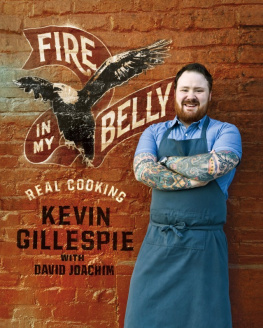


I dedicate this book to all the amazing women in my life. For those who are here today and those who live on in my memories, its your strength that reminds me of what true greatness looks like.
CONTENTS

TOP: Sunshine Circle, Locust Grove, Georgiahome to lots of Gillespies.
BOTTOM: Mom, Dad, and Granny.
INTRODUCTION
WHAT DRIVES ME TO COOK
My aunt Lynn named our street Sunshine Circle. Before that, it was just a dirt road in Locust Grove, Georgia. My granny moved there in the 1970s from the mountains near Walhalla, South Carolina. She tried to re-create what her generation had in the mountainsan extended but close-knit family all living together on a big stretch of land. My uncle Clint and his wife, Lynn, bought the lot next door; my aunt Debbie and her husband settled across the road; and my mom and dad bought the piece of land at the end of the road.
I grew up with nine cousins, all within five years of age and 500 yards of each other. Our parents worked in and around Atlanta. Granny took care of the kids. My mom cooked as much as she could, but like most working parents, she didnt have a lot of time. Granny woke up at the crack of dawn to cook one meal, clean it up, and then start cooking the next. She made it possible for the whole family to sit down and share meals together every day.
Sometime in the fifth grade, I decided someone else in the family should know how to cook. I caught the chef bug at a young age, and my family got behind me 100 percent. Granny let me help out in the kitchen, and she turned on PBS cooking shows. My grandmother on my mothers side bought me cookbooks from TV chefs like Emeril Lagasse and encouraged me to step outside my comfort zone instead of just cooking the food I grew up with. Uncle Richard took me to fancy restaurants. He has a cable company with job sites all over the country. We went to Emerils in New Orleans; ate Mexican food in Phoenix and Tucson; had fresh fish in Oregon; and dined in Atlantas best restaurants, like Bacchanalia and Panos and Pauls. Uncle Richard thought nothing of buying me a whole rib eye to cook with. He ate all of my cooking experiments.
Eventually, I had to tell my parents that I didnt want to be an engineer. I was terrified to talk to them about it. But my mom didnt bat an eyelash. Im so glad you know now who you want to become, she said. You could waste a lot of your life trying to figure that out.
I got a scholarship to the Massachusetts Institute of Technology (MIT). Instead of going to MIT, I went to culinary school at the Art Institute of Atlanta and helped pay for it with a scholarship I won in a national cooking competition. After a few years of working in Atlantas top restaurants, I needed a change of scenery and moved to Portland, Oregon. Portlanders are militantly seasonal in their cooking. That was how Granny always cooked, and I was immediately drawn to it. Out there, my appreciation for fresh, high-quality ingredients grew deeper. When I moved back to Atlanta, I took over the kitchen at Woodfire Grill, one of the citys leading farm-to-table restaurants. Since then, my main focus has been on cooking with ingredients available in and around Georgia at any given time of the year. When the seasons change, the dishes change. I cooked the same way when I competed on Bravo TVs Top Chef. I created dishes on the spot based on what was available to us at that time of year. I firmly believe that good cooking starts with good ingredients. I would even argue that cooking is, at its root, figuring out the great qualities of any food and then making those qualities shine.

Thats the philosophy behind the recipes in this book. I created most of them from scratch. This is not a chefs book crammed with difficult dishes; there are only a handful of recipes from Woodfire Grill, like the is another one from the restaurant. Its my single most-requested recipe, and I finally wrote it down.
Just about everything else here was developed specifically for home cooks. Theres a huge range of recipeseverything from . I eat all kinds of food. When creating the recipes, I let my taste buds guide me. Sometimes I folded in a flavor memory from a dish I tasted somewhere at some point. But mostly, I tried to amplify and balance the taste of the ingredients themselves. In writing the recipes, my goal was to get you to do the same thing on your own, to encourage you to really start cooking instead of just following a recipe. Real cooking is flying by the seat of your pants. Its finding some inspiration among the ingredients in front of you or your favorite techniques and putting them together to make something good to eat.

Sauting with the "washing machine method" at Woodfire Grill.

Joe Reynolds from Love Is Love Farm.

LEFT TO RIGHT: Aunt Lynn, Kayla (my sister), Kevin Sr. (my dad), Chris, Cathy (my mom), Katie, Geneva, Kevin Jr. (me), Aunt Debbie, and Uncle Mike; Abigail and Aubrey (cousins)
Thats why I did away with some of the old ways of writing a recipe. Instead of writing 1 cup chopped onions, I wrote things like Onion1 baseball-size, chopped. That simple switch puts the ingredient first and the measurement secondthe right order of things, if you ask me. It gets you to think more like a chef. Likewise, I didnt just write a list of cooking instructions. I tried to explain here and there why you do things a certain way. These little explanations help you become a better cook.
But maybe you dont care about cooking better. Maybe you just want something completely delicious to eat. Youll find that here too. These recipesand the whole book, for that matterare a direct result of my dreaming up delicious things that I couldnt help but share with my family and friends, and now with you. Thats what drives me to cook. Thats the fire in my belly.

My old recipe book. This is a recipe for a white asparagus dish written in German.
CHAPTER
WHAT I MEAN WHEN I SAY...
A couple years ago at Woodfire Grill, we were serving a carrot dish that was made at the cold station in the restaurant kitchen. At that time, a cook named John was at the station, and he was responsible for making the dish. It was an exploration of carrot with four different components: a cold carrot broth, a carrot gele, baby carrots, and a carrot sauce. This was a technical dish that was difficult to execute. The components needed to be served on the same plate but at slightly different temperatures so the flavors would come across properly. This was right after Top Chef Season 6 had aired, so the restaurant was getting busy, and I was fielding a lot of calls. I quickly summed up for John why he needed to constantly move the sauce from the oven to the cold station to maintain the correct temperature of the sauce. I remember saying, It needs to be just above below room temperature. Thats a crazy-ass way of putting it, but the phrase made perfect sense to me.
Next page




















